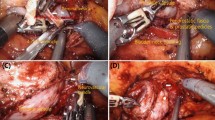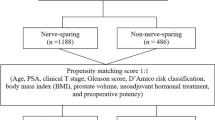Abstract
Purpose
To evaluate the neurovascular bundle preservation grades during robotic-assisted radical prostatectomy and compared to the trifecta combined outcome (oncologic control, continence, and sexual function) twelve months after the surgery.
Methods
Cohort of patients who underwent nerve-sparing robotic-assisted radical prostatectomy had the neurovascular bundle preservation retrospectively graded from 0 to 8 according to the Hopkins subjective visual classification. Patients then were divided into two groups, according to the median of nerve-sparing grading: those with score six or high and those with score less than six. Main outcome was the trifecta combined outcome and secondary outcomes was the individual trifecta criteria (prospective analysis). A secondary analysis with groups divided according to pre-operatory SHIM score was made.
Results
One hundred robotic-assisted nerve-sparing radical prostatectomy were performed, of which 83 were included. There were 53 patients with grading greater than or equal to six (group 1) and 30 patients less than six (group 2). 66.6% patients (35/53) in group 1 had a trifecta combined outcome of compared to 33.3% (10/30) in group 2 (p = 0.017). Individually, the erectile function was higher in group 1 (73.6%) compared to group 2 (46.7%) (p = 0.014). Both the results of the combined endpoint trifecta and erection were also maintained in the group with preoperative SHIM ≥ 17.
Conclusions
The grading of preservation of the neurovascular bundle in radical prostatectomy is related to a better combined trifecta outcome one year after surgery.
Similar content being viewed by others
References
Walsh PC, Donker PJ (1982) Impotence following radical prostatectomy: insight into etiology and prevention. J Urol 128:492–497
Walsh PC, Lepor H, Eggleston JC (1983) Radical prostatectomy with preservation of sexual function: anatomical and pathological considerations. Prostate 4:473–485
Walsh PC, Mostwin JL (1984) Radical prostatectomy and cystoprostatectomy with preservation of potency. Results using a new nerve-sparing technique. Br J Urol 56(6):694–697. https://doi.org/10.1111/j.1464-410x.1984.tb06149.x (PMID: 6534493)
Burkhard FC, Kessler TM, Fleischmann A et al (2006) Nerve Sparing open radical retropubic prostatectomy—does it have an impact on urinary incontinence? J Urol 179:189–195
Levinson AW, Pavlovich CP, Ward NT, Link RE, Mettee LZ, Su LM (2008) Association of surgeon subjective characterization of nerve sparing quality with potency following laparoscopic radical prostatectomy. J Urol 179:1510–1514
Schatloff O, Chauhan S, Sivaraman A (2012) Anatomic grading of nerve sparing during robot-assisted radical prostatectomy. Eur Urol. https://doi.org/10.1016/j.eururo.2011.12.048
Kaye DR, Hyndman ME, Segal RL et al (2013) Urinary outcomes are significantly affected by nerve sparing quality during radical prostatectomy. Urology. https://doi.org/10.1016/j.urology.2013.06.067
Bianco FJ Jr, Scardino PT, Eastham JA (2005) Radical prostatectomy: long-term cancer control and recovery of sexual and urinary function (“trifecta”). Urology 66(5 Suppl):83–94. https://doi.org/10.1016/j.urology.2005.06.116 (PMID: 16194712)
Wilt TJ, Brawer MK, Jones KM et al (2012) Radical prostatectomy versus observation for localized prostate cancer. N Engl J Med 367(3):203–213. https://doi.org/10.1056/NEJMoa1113162 (Published correction appears in N Engl J Med. 2012 Aug 9;367(6):582)
Hamdy FC, Donovan JL, Lane JA et al (2016) 10-year outcomes after monitoring, surgery, or radiotherapy for localized prostate cancer. N Engl J Med 375(15):1415–1424. https://doi.org/10.1056/NEJMoa1606220
Bourke L, Boorjian SA, Briganti A, Klotz L, Mucci L, Resnick MJ, Rosario DJ, Skolarus TA, Penson DF (2015) Survivorship and improving quality of life in men with prostate cancer. Eur Urol 68(3):374–383. https://doi.org/10.1016/j.eururo.2015.04.023 (Epub 2015 May 1. PMID: 25941049)
Bill-Axelson A, Holmberg L, Garmo H et al (2014) Radical prostatectomy or watchful waiting in early prostate cancer. N Engl J Med 370(10):932–942. https://doi.org/10.1056/NEJMoa1311593
Sanda MG, Dunn RL, Michalski J et al (2008) Quality of life and satisfaction with outcome among prostate-cancer survivors. N Engl J Med 358(12):1250–1261. https://doi.org/10.1056/NEJMoa074311
Moskovic DJ, Alphs H, Nelson CJ et al (2011) Subjective characterization of nerve sparing predicts recovery of erectile function after radical prostatectomy: defining the utility of a nerve sparing grading system. J Sex Med 8(1):255–260. https://doi.org/10.1111/j.1743-6109.2010.01972.x
Tewari AK, Srivastava A, Huang MW et al (2011) Anatomical grades of nerve sparing: a risk-stratified approach to neural-hammock sparing during robot-assisted radical prostatectomy (RARP). BJU Int 108(6 Pt 2):984–992. https://doi.org/10.1111/j.1464-410X.2011.10565.x
Kang SG, Schatloff O, Haidar AM et al (2015) Does surgeon subjective nerve sparing score predict recovery time of erectile function following robot-assisted radical prostatectomy? J Sex Med 12(6):1490–1496. https://doi.org/10.1111/jsm.12844
Bajpai RR, Razdan S, Sanchez MA, Razdan S (2019) A novel intraoperative physician-assigned grading score to predict postoperative return of potency at 1 year after robotic-assisted laparoscopic prostatectomy. Indian J Urol 35(1):61–66. https://doi.org/10.4103/iju.IJU_158_18
Avulova S, Zhao Z, Lee D et al (2018) The effect of nerve sparing status on sexual and urinary function: 3-year results from the CEASAR study. J Urol 199(5):1202–1209. https://doi.org/10.1016/j.juro.2017.12.037 (Published correction appears in J Urol. 2018 Aug;200(2):458)
Seetharam Bhat KR, Moschovas MC, Sandri M et al (2021) Stratification of potency outcomes following robot-assisted laparoscopic radical prostatectomy based on age, preoperative potency, and nerve sparing. J Endourol 35(11):1631–1638. https://doi.org/10.1089/end.2021.0141
Srivastava A, Chopra S, Pham A et al (2013) Effect of a risk-stratified grade of nerve-sparing technique on early return of continence after robot-assisted laparoscopic radical prostatectomy. Eur Urol 63(3):438–444. https://doi.org/10.1016/j.eururo.2012.07.009 (Published correction appears in Eur Urol. 2015 Oct;68(4):744)
Walz J, Epstein JI, Ganzer R et al (2016) A critical analysis of the current knowledge of surgical anatomy of the prostate related to optimisation of cancer control and preservation of continence and erection in candidates for radical prostatectomy: an update. Eur Urol 70(2):301–311. https://doi.org/10.1016/j.eururo.2016.01.026
Funding
The authors did not receive support from any organization for the submitted work. No funds, grants, or other support was received.
Author information
Authors and Affiliations
Contributions
ARHG: Protocol/project development, Data collection or management, Data analysis, Manuscript writing/editing. LMB: Protocol/project development, Data analysis, Manuscript writing/editing. ETC: Data collection or management. PGK: Data collection or management. PWB: Data collection or management. AOP: Data collection or management. RDC: Protocol/project development, Data analysis. TER: Protocol/project development, Data analysis. MB: Protocol/project development, CPP: Protocol/project development, Manuscript writing/editing. BSN: Protocol/project development, Manuscript writing/editing.
Corresponding author
Ethics declarations
Conflict of interest
The authors have no competing interests to declare that are relevant to the content of this article.
Ethical approval
All procedures performed in studies involving human participants were in accordance with the ethical standards of the institutional and/or national research committee and with the 1964 Helsinki Declaration and its later amendments or comparable ethical standards. This study was approved by the research ethics committee of our hospital, under the number CAAE 02658218.0.0000.5327. The previously collected database had also been approved by the research ethics committee, under number CAAE 59735716.2.0000.5327.
Informed consent
Informed consent was obtained from all individual participants included in the study.
Additional information
Publisher's Note
Springer Nature remains neutral with regard to jurisdictional claims in published maps and institutional affiliations.
Rights and permissions
Springer Nature or its licensor (e.g. a society or other partner) holds exclusive rights to this article under a publishing agreement with the author(s) or other rightsholder(s); author self-archiving of the accepted manuscript version of this article is solely governed by the terms of such publishing agreement and applicable law.
About this article
Cite this article
Görgen, A.R.H., Burttet, L.M., Cachoeira, E.T. et al. Association of nerve-sparing grading in robotic radical prostatectomy and trifecta outcome. World J Urol 40, 2925–2930 (2022). https://doi.org/10.1007/s00345-022-04196-9
Received:
Accepted:
Published:
Issue Date:
DOI: https://doi.org/10.1007/s00345-022-04196-9




